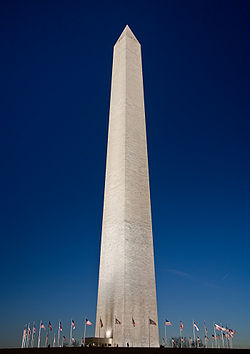Vietnam Veterans Memorial
| Vietnam Veterans Memorial | |
|---|---|
|
IUCN Category V (Protected Landscape/Seascape)
|
|
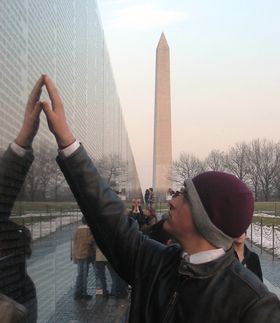 |
|
 |
|
| Location | Washington, D.C., United States |
| Area | 2.00 acres (8,100 m²) |
| Established | November 13, 1982 |
| Visitors | 3,799,968 (in 2005) |
| Governing body | National Park Service |
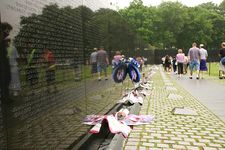
The Vietnam Veterans Memorial is a national memorial in Washington, D.C. It honors U.S. service members of the U.S. armed forces who fought in the Vietnam War, service members who died in service in Vietnam/South East Asia, and those service members who were unaccounted for (Missing In Action) during the War.
Its construction and related issues have been the source of controversies, some of which have resulted in additions to the memorial complex. The memorial currently consists of three separate parts: the Three Soldiers statue, the Vietnam Women's Memorial, and the Vietnam Veterans Memorial Wall, which is the best-known part of the memorial.
The memorial was inspired by Jan Scruggs, an infantryman who served in Vietnam with the U.S. Army's 199th Light Infantry Brigade. In March 1979, he saw The Deer Hunter, which reminded him "of the people he'd seen suffer and die in Vietnam". That night he decided to build a memorial with the names of everyone killed in the Vietnam War.[1]
The main part of the memorial, which was completed in 1982, is in Constitution Gardens adjacent to the National Mall, just northeast of the Lincoln Memorial. The memorial is maintained by the U.S. National Park Service, and receives around 3 million visitors each year. The Memorial Wall was designed by U.S. landscape architect Maya Lin. The typesetting of the original 58, 627 names on the wall was performed by Datalantic in Atlanta, Georgia. In 2007, it was ranked tenth on the "List of America's Favorite Architecture" by the American Institute of Architects.
Contents |
History
- April 30, 1975 – The Fall of Saigon.
- April 27, 1979 – The Vietnam Veterans Memorial Fund, Inc. (VVMF), was incorporated as a non-profit organization to establish a memorial to veterans of the Vietnam War. Much of the impetus behind the formation of the fund came from a wounded Vietnam veteran, Jan Scruggs, who was inspired by the film The Deer Hunter. Eventually, $8.4 million was raised by private donations.
- July 1, 1980 – Congress authorizes 3 acres (12,000 m2) near the Lincoln Memorial for the site. The "temporary" Munitions Building, built for War Department offices during World War I and finally razed in 1965, formerly occupied the site. The memorial is to be managed by the National Park Service under its National Mall and Memorial Parks group. A design competition is announced.
- December 29, 1980 – 2,573 register for design competition with a prize of $50,000.
- March 31, 1981 – 1,421 designs submitted. The designs are displayed at an airport hangar at Andrews Air Force Base for the selection committee, in rows covering more than 35,000 square feet (3,300 m2) of floor space. Each entry was identified by number only, to preserve the anonymity of their authors. All entries were examined by each juror; the entries were narrowed down to 232, finally 39. The jury selected entry number 1026.
- May 6, 1981 – A jury of eight architects and sculptors (Harry Weese, Richard Hunt, Garret Eckbo, Costantino Nivola, James Rosati, Grady Clay, Hideo Sasaki, Pietro Belluschi, working with architectural advisor Paul Spreiregen)[2] unanimously selected a design by Maya Ying Lin, a 21-year-old Yale University architecture student from Athens, Ohio, as the winner from 1,421 entries.
- January 1982 – The Three Soldiers was added to the design as a result of controversy over Lin's design.
- March 11, 1982 – The design is formally approved.
- March 26, 1982 – Ground is formally broken.
- October 13, 1982 – The U.S. Commission of Fine Arts approves erection of a flagpole to be grouped with sculptures.
- November 13, 1982 – Memorial dedication after a march to its site by thousands of Vietnam War veterans. As a National Memorial it was administratively listed on the National Register of Historic Places the same day.
- November 11, 1993 – Vietnam Women's Memorial is dedicated.
- November 1984 – The Three Soldiers statue is dedicated.
- 1994 – The Pentagon, instead of adding two unidentified bodies of Vietnam veterans to the Tomb of the Unknowns, recommended that a display of medals be added behind the tomb with a plaque reading: "Let all know that the United States of America pays tribute to the members of the Armed Forces who answered their country's call." A Veterans Affairs subcommittee later changed the statement to read: "Let all know that the United States of America pays tribute to the members of the Armed Forces who served honorably in Southeast Asia during the Vietnam Era." Later, in 1998, Congress, prodded by the Vietnam-Era Caucus (composed of veteran Congressmen), discussed creating a "Vietnam Veterans Week" to honor the survivors of the war.
- November 10, 2004 – Dedication of memorial plaque honoring veterans who died after the war as a direct result of injuries suffered in Vietnam, but who fall outside Department of Defense guidelines.
Structure
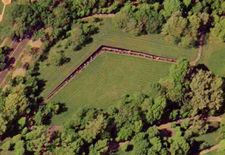
Memorial Wall
The Memorial Wall, designed by Maya Lin, is made up of two black granite walls 246 feet 9 inches (75 m) long. The walls are sunk into the ground, with the earth behind them. At the highest tip (the apex where they meet), they are 10.1 feet (3 m) high, and they taper to a height of eight inches (20 cm) at their extremities. Granite for the wall came from Bangalore, Karnataka, India, and was deliberately chosen because of its reflective quality. Stone cutting and fabrication was done in Barre, Vermont. Stones were then shipped to Memphis, Tennessee where the names were etched. The etching was completed using a photoemulsion and sandblasting process. The negatives used in the process are in storage at the Smithsonian Institution. When a visitor looks upon the wall, his or her reflection can be seen simultaneously with the engraved names, which is meant to symbolically bring the past and present together. One wall points toward the Washington Monument, the other in the direction of the Lincoln Memorial, meeting at an angle of 125° 12′. Each wall has 72 panels, 70 listing names (numbered 1E through 70E and 70W through 1W) and 2 very small blank panels at the extremities. There is a pathway along the base of the Wall, where visitors may walk, read the names, make a pencil rubbing of a particular name, or pray.
Inscribed on the walls with the Optima typeface are the names of servicemen who were either confirmed to be KIA (Killed in Action) or remained classified as MIA (Missing in Action) when the walls were constructed in 1982. They are listed in chronological order, starting at the apex on panel 1E in 1959 (although it was later discovered that the first casualties were military advisers who were killed by artillery fire in 1957), moving day by day to the end of the eastern wall at panel 70E, which ends on May 25, 1968, starting again at panel 70W at the end of the western wall which completes the list for May 25, 1968, and returning to the apex at panel 1W in 1975. Symbolically, this is described as a "wound that is closed and healing." Information about rank, unit, and decorations are not given. The wall listed 58,159 names when it was completed in 1993; as of May 2007[update], there are 58,261 names, including 8 women. Approximately 1,200 of these are listed as missing (MIAs, POWs, and others), denoted with a cross; the confirmed dead are marked with a diamond. If the missing return alive, the cross is circumscribed by a circle (although this has never occurred as of March 2009[update]); if their death is confirmed, a diamond is superimposed over the cross. According to the Vietnam Veterans Memorial Fund, "there is no definitive answer to exactly how many, but there could be as many as 38 names of personnel who survived, but through clerical errors, were added to the list of fatalities provided by the Department of Defense."[3] Directories are located on nearby podiums so that visitors may locate specific names.
Beginning and ending timeline for those listed on the wall
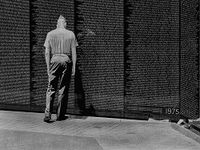
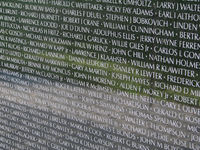
- November 1, 1955 – Dwight D. Eisenhower deploys Military Assistance Advisory Group to train the South Vietnamese military units and secret police. However, the U.S. Department of Defense does not recognize such date since the men were supposedly only training the Vietnamese. The officially recognized date is the formation of the Military Assistance Command Viet-Nam, better known as MACV. This marks the official beginning of American involvement in the war as recognized by the memorial.
- June 8, 1956 – The first official death in Vietnam is U.S. Air Force Technical Sergeant Richard B. Fitzgibbon, Jr. of Stoneham, MA who was killed by another U.S. airman.
- October 21, 1957 – U.S. Army Special Forces Captain Harry G. Cramer is killed during a training action. He is added to the wall after its dedication.
- July 8, 1959 – Charles Ovnand and Dale R. Buis are killed by guerrillas at Bien Hoa while watching the film The Tattered Dress. They are listed 1 and 2 at the wall's dedication. Ovnand's name is misspelled on the memorial as "Ovnard."
- April 30, 1975 – Fall of Saigon. The U.S. Department of Veterans Affairs uses May 7, 1975 as the official end date for the Vietnam era as defined by Title 38 U.S. Code Section 101.
- May 15, 1975 – 18 Marines are killed on the last day of a rescue operation known as the Mayagüez incident with troops from the Khmer Rouge in Cambodia. They are the last servicemen listed on the timeline (Daniel A. Benedett, Lynn Blessing, Walter Boyd, Gregory S. Copenhaver, Andres Garcia, Bernard Gause, Jr., Gary L. Hall, Joseph N. Hargrove, James J. Jacques, Ashton N. Loney, Ronald J. Manning, Danny G. Marshall, James R. Maxwell, Richard W. Rivenburgh, Elwood E. Rumbaugh, Antonio Ramos Sandovall, Kelton R. Turner, Richard Vande Geer).
The Three Soldiers
A short distance away from the wall is another Vietnam memorial, a bronze statue named The Three Soldiers (sometimes called The Three Servicemen). Negative reactions to Lin's design created a controversy; a compromise was reached by commissioning Frederick Hart (who had placed third in the original design competition) to produce a bronze figurative sculpture in the heroic tradition in order to complement the memorial wall. The statue was unveiled in 1984 and depicts three soldiers, purposefully identifiable as White American, African American, and Hispanic American. The statue and the Wall appear to interact with each other, with the soldiers looking on in solemn tribute at the names of their dead comrades. The distance between the two allows them to interact while minimizing the impact of the addition on Lin's design.
Women's Memorial
Also part of the memorial is the Vietnam Women's memorial. It is located a short distance south of the Wall, north of the Reflecting Pool. It was designed by Glenna Goodacre and dedicated on November 11, 1993, to the women of the United States who served in the Vietnam War, most of whom were nurses. The woman looking up is named Hope, the woman praying is named Faith, and the woman tending to a wounded soldier is named Charity.
In Memory memorial plaque
A memorial plaque, authorized by Pub.L. 106-214, was dedicated on November 10, 2004, at the northeast corner of the plaza surrounding the Three Soldiers statue to honor veterans who died after the war as a direct result of injuries suffered in Vietnam, but who fall outside Department of Defense guidelines. The plaque is a carved block of black granite, 3 feet (0.91 m) by 2 feet (0.61 m), inscribed "In memory of the men and women who served in the Vietnam War and later died as a result of their service. We honor and remember their sacrifice."
Ruth Coder Fitzgerald, founder of The Vietnam War In Memory Memorial Plaque Project, worked for years and struggled against opposition to have the In Memory Memorial Plaque completed. The organization was disbanded, but their web site is maintained by the Vietnam War Project at Texas Tech University.
Controversies

The Vietnam War was one of the longest and most controversial wars in United States history. A stated goal of the memorial fund was to avoid commentary on the war itself, serving solely as a memorial to those who served. Nevertheless, a number of controversies have surrounded the memorial.
Maya Lin
As depicted in a documentary about Maya Ying Lin (Maya Ying Lin: A Strong Clear Vision), reactions to the chosen memorial design were intensely mixed. At the time of the contest, Lin was a young student at Yale University. The wall was designed as a class project for a funerary design class.
Veterans' opposition to design
The unconventionality of the selected design was very controversial, especially among veterans. Many publicly voiced their displeasure, calling the wall "a black gash of shame."[4] Two prominent early supporters of the project, H. Ross Perot and James Webb, withdrew their support from the project once they saw the design. Said Webb, “I never in my wildest dreams imagined such a nihilistic slab of stone.” James Watt, Secretary of the Interior under President Reagan, initially refused to issue a building permit for the memorial due to the public outcry about the design.[5]
Once the design was realized, the overwhelming majority of the design's critics came to appreciate the simple beauty and emotional power of the wall, and such controversy quickly evaporated. In the words of Scruggs, "It has become something of a shrine."[4]
Women's memorial
The original winning entry of the Women's Memorial design contest was deemed unsuitable. Glenna Goodacre's entry received an honorable mention in the contest and she was asked to submit a modified maquette (design model). Goodacre's original design for the Women's Memorial statue included a standing figure of a nurse holding a Vietnamese baby, which although not intended as such, was deemed a political statement, and it was asked that this be removed. She replaced them with a figure of a kneeling woman holding an empty helmet.
Traveling replicas
The Moving Wall
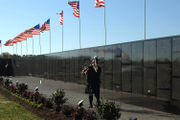
Vietnam veteran John Devitt of Stockton, California, attended the 1982 dedication ceremonies of the Vietnam Veterans Memorial. Recognizing what he saw as the healing nature of the Wall, he vowed to make a transportable version of the Wall, a "Traveling Wall" so those who were not able to travel to Washington, D.C. would be able to see and touch the names of friends or loved ones in their own home town.
Using personal finances, John founded Vietnam Combat Veterans, Ltd. With the help of friends, the half-size replica of the Vietnam Veterans Memorial, named The Moving Wall,[6] was built and first put on display to the public in Tyler, Texas, in 1984.
The Moving Wall visits hundreds of small towns and cities throughout the U.S., staying five or six days at each site. Local arrangements for each visit are made months in advance by veterans organizations and other civic groups. Thousands of people all over the US volunteered their time and money to help honor the fallen.
Desire for a hometown visit of The Moving Wall was so high the waiting list became long. Vietnam Combat Veterans built a second structure of The Moving Wall. A third structure was added in 1989. In 2001, one of the structures was retired due to wear.
By 2006, there had been more than hometown visits of The Moving Wall. The count of people who visited The Moving Wall at each display ranges from 5,000 to more than 50,000; the total estimate of visitors is in the tens of millions.
As the wall moves from town to town on interstates, it is often escorted by state troopers and up to thousands of local citizens on motorcycles. Many of these are Patriot Guard Riders, who consider escorting The Moving Wall to be a "special mission", which is coordinated on their website. As it passes towns, even when it is not planning a stop in those towns, local veterans organizations sometimes plan for local citizens to gather by the highway and across overpasses to wave flags and salute the Wall.[6]
The Wall That Heals
The Wall That Heals is a traveling half-scale replica of the Vietnam Veterans Memorial started in 1996 by the Vietnam Veterans Memorial Fund. It also features a Traveling Museum and Information Center.[7]
Wildwoods Vietnam Veterans Memorial Wall
Located across Ocean Avenue from the Wildwoods Convention Center, the memorial was unveiled and dedicated on May 29, 2010. The memorial wall is a half-size granite replica of the Vietnam Memorial in Washington, D.C., and the only permanent memorial in the Northeast, other than the Memorial in the National's Capital.
As a Memorial Genre
The first US memorial to an ongoing war, the Northwood Memorial in Irvine, CA, is modelled on the Vietnam Veterans memorial in that it includes a chronological list of the dead engraved in dark granite. As the memorialized wars (the Iraq and the AfPak long war) have not concluded, the Northwood Memorial will have blank space upon completion (August 2010) and will be up dated yearly. It has space for about 8000 names, of which approximately 6000 are occupied to date.[8][9]
Vietnam Veterans Memorial Collection
Visitors to the memorial began leaving sentimental items at the memorial at its opening. One story claims that this practice began during construction, when a Vietnam veteran threw the purple heart his brother received posthumously into the concrete of the memorial's foundation.[10] Several thousand items are left at the memorial each year.
Items left at the Vietnam Veterans Memorial are collected by National Park Service employees and transferred to the NPS Museum and Resource Center, which catalogs and stores all items except perishable organic matter (such as live flowers) and unaltered US flags. The flags are redistributed through various channels.[11]
The largest item left at the memorial was a sliding glass storm door with a full-size replica "tiger cage". The door was painted with a scene in Vietnam and the names of US POWs and MIAs from the conflict.[10]
Other items in collection include a Harley-Davidson motorcycle with the license plate HERO, a plain brown teddy bear which was dressed by other unconnected visitors, a 6' abstract sculpture titled "After the Holocaust", and an experimental W. R. Case "jungle survival knife" of which only 144 were made. It also contains the Medal of Honor of Angelo Liteky, who renounced it in 1986 by placing the medal at the memorial in an envelope addressed to then-President Ronald Reagan.
From 1992 to 2003, selected items from the collection were placed on exhibit, at the Smithsonian Institution's National Museum of American History as "Personal Legacy: The Healing of a Nation".
See also
- Vietnam Forces National Memorial, Canberra
- Vietnam Veterans Memorial (The Wall-USA), an online memorial
- Vietnam Veterans of America, chartered by Congress and campaigns on issues important to Vietnam veterans
- The Virtual Wall, an online memorial
- The Wall That Heals, a 1997 film
- s:Maya Lin's original competition submission for the Vietnam Veterans Memorial
- Northwood Memorial
Notes
- ↑ Scruggs, Jan C., and Joel L. Swerdlow. 1985. To heal a nation: the Vietnam Veterans Memorial. New York: Harper & Row. p 7
- ↑ Vietnam Veterans Memorial lessons for September 11
- ↑ "Vietnam Memorial Fund – FAQs". http://www.vvmf.org/index.cfm?SectionID=85.
- ↑ 4.0 4.1 Garber, Kent (2007-11-03). "A Milestone for a Memorial That Has Touched Millions". U.S. News and World Report (Washington, DC). http://www.usnews.com/articles/news/2007/11/03/milestone-for-a-memorial-that-has-touched.html. Retrieved 2009-11-11.
- ↑ Wills, Denise (2007-11-01). "The Vietnam Memorial's History". Washingtonian.com (Washington, DC). http://www.washingtonian.com/articles/people/5595.html. Retrieved 2009-11-11.
- ↑ 6.0 6.1 "Local AMVETS to Salute Wall". Greenville Advocate. July 17, 2007.
- ↑ The Wall That Heals Vietnam Veterans Memorial Fund
- ↑ northwoodmemorial.com
- ↑ "Letter from Sukhee Kang". 3.bp.blogspot.com. 2010-02-22. http://3.bp.blogspot.com/_ihsLW9amV1E/S4R1kx2Z-vI/AAAAAAAAAhs/F0gIKTbHiTs/s1600-h/northwood_memorial.jpg. Retrieved 2010-06-21.
- ↑ 10.0 10.1 http://www.nps.gov/mrc/vvmc/faq2.htm<
- ↑ "MRCE:Frequently Asked Questions". Nps.gov. http://www.nps.gov/mrc/vvmc/faqs.htm. Retrieved 2010-06-21.
References

- Vietnam Veterans Memorial, National Park Service leaflet, GPO:2004—304–377/00203
- The National Parks: Index 2001–2003. Washington: U.S. Department of the Interior.
Further reading
- Ashabranner, Brent K., Always to Remember: The Story of the Vietnam Veterans Memorial, Putnam, New York 1989.
- Ashabranner, Brent K., Their Names to Live: What the Vietnam Veterans Memorial Means to America, Twenty-first Century Press, Brookfield CT, 1998.
- Berdahl, Daphne, "Voices at the Wall: Discourses of Self, History and National Identity at the Vietnam Veterans Memorial," History & Memory: Studies in Representation of the Past 6 (Fall/Winter 1994), 88–124.
- Blair, Carole, Jeppeson, Marsha S., and Pucci, Enrico Jr., "Public Memorializing in Postmodernity: The Vietnam Veterans Memorial as Prototype," Quarterly Journal of Speech 77 (August 1991), 263–288.
- Capasso, Nicholas, The National Vietnam Veterans Memorial in Context: Commemorative Public Art in America, 1960–1997, Ph.D. Thesis, Rutgers University, 1998.
- Carlson, A. Cheree, and Hocking, John E., "Strategies of Redemption at the Vietnam Veterans Memorial," Western Journal of Speech Communication 52 (September 1988), 203–215.
- Carney, Lora S., "Not Telling Us What to Think: The Vietnam Veterans Memorial," Metaphor and Symbolic Activity 8 (1993), 211–219.
- Danto, Arthur, "The Vietnam Veterans Memorial," The Nation, 31 August 1985, 152–155.
- Ellis, Caron S., "So Old Soldiers Don't Fade Away: The Vietnam Veterans Memorial," Journal of American Culture 15 (Summer 1992), 25–28.
- Ehrenhaus, Peter, "Silence and Symbolic Expression," Communication Monographs 55 (March 1988), 41–57.
- Foss, Sonja K, "Ambiguity as Persuasion: The Vietnam Veterans Memorial," Communication Quarterly 34 (Summer 1986), 326–340.
- Friedman, Daniel S., "Public Things in the Modern City: Belated Notes on Tilted Arc and the Vietnam Veterans Memorial," JAE: Journal of Architectural Education 49 (November 1995), 62–78.
- Griswold, Charles L., "The Vietnam Veterans Memorial and the Washington Mall: Philosophical Thoughts on Political Iconography," Critical Inquiry 12 (Summer 1986), 688–719.
- Haines, Harry, "'What Kind of War?': An Analysis of the Vietnam Veterans Memorial," Critical Studies in Mass Communucation 3 (1986), 1–20.
- Hass, Kristin Ann. Carried to the Wall: American memory and the Vietnam Veterans Memorial. Berkeley: University of California Press, 1998.
- Hess, Elizabeth, "Vietnam: Memorials of Misfortune," in Unwinding the Vietnam War: From War into Peace (Reese Williams, ed.), Real Comet Press, Seattle 1987, 261–270.
- Hubbard, William, "A Meaning for Monuments," The Public Interest 74 (Winter 1984), 17–30.
- Katakis, Michael, The Vietnam Veterans Memorial, Crown, New York 1988.
- Lopes, Sal, The Wall: Images and Offerings from the Vietnam Veterans Memorial Collins, New York 1987.
- McLeod, Mary, "The Battle for the Monument: The Vietnam Veterans Memorial," in The Experimental Tradition (Helene Lipstadt, ed.), Rizzoli, New York 1989, 115–137.
- Morrissey, Thomas F., Between the Lines: Photographs from the National Vietnam Veterans Memorial, Syracuse University Press, Syracuse 2000.
- Ochsner, Jeffrey Karl, “A Space of Loss: The Vietnam Veterans Memorial.” JAE: Journal of Architectural Education 50 (February 1997), 156–171.
- Palmer, Laura, Shrapnel in the Heart: Letters and Remembrances from the Vietnam Veterans Memorial, Random House, New York 1987.
- Resnicoff, Arnold E., Dedication Prayer for the Vietnam Veterans Memorial," in "The Treasury of American Prayer," James P. Moore, Jr., editor, Doubleday, 2009, pg. 317.
- Scott, Grant F., "Meditations in Black: The Vietnam Veterans Memorial," Journal of American Culture 13 (Fall 1990), 37–40.
- Scruggs, Jan C., and Swerdlow, Joel L., To Heal a Nation: The Vietnam Veterans Memorial, Harper & Row, New York 1985.
- Sturken, Marita, "The Wall, the Screen, and the Image: The Vietnam Veterans Memorial," Representations 35 (Summer 1991), 118–142.
- Wagner-Pacific, Robin, & Schwartz, Barry, "The Vietnam Veterans Memorial: Commemorating a Difficult Past." The American Journal of Sociology, 97 (1991), 376–420.
External links
- Official NPS website: Vietnam Veterans Memorial
- The Virtual Wall (TM)
- View The Wall
- Maya Ying Lin's Vietnam Veterans Memorial proposal at the Library of Congress
- The Moving Wall (TM)
- Vietnam Veterans Wall South in Pensacola, FL (aka 'The Wall South')
- Photo essay: Valentine's Day at the U.S. Viet Nam War Memorial (Wikinews article)
- Maya Lin article in Seattle Weekly
- Bringing Home the Wall
- The Vietnam Veterans Memorial (The Wall-USA) website
- Photos of the Wall at "Sites of Memory"
- Army Medical Statistics
- Vietnam Veterans of America
- The Merry Prankster, chapter 12 of Prisoners of Hope by Susan Katz Keating, describing actions by Ted Sampley
- History of the Wall at aiipowmia.com, a group involved with the POW-MIA controversy.
- NW Veterans – Vietnam's Women
- Online version of the Washington D.C. Memorial
- Photo Collection of Vietnam Veterans Memorial in Washington DC
- A Wall As Witness Documentary about how the Wall is both a Wall of Healing and a Wall that holds many heartaches. Features interviews by Special Assistant to the Director of the POW/MIA Office at the Department of Defense, Adrian Cronauer; Gold Star Mother, Ann Sherman Wolcott; Rolling Thunder Founder, Artie Muller; and the most decorated Vietnam Veteran, David Christian.
- Interactive Vietnam Veterans Memorial Leave a tribute, a story or photograph about any of the 58,256 veterans killed.
- Vietnam Unit Memorial Monument, Coronado California
- Prayer at 1982 dedication ceremony.
|
||||||||||||||||
